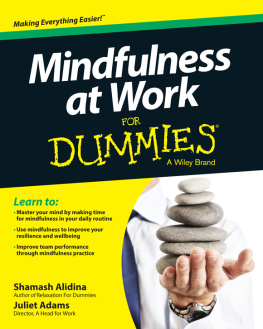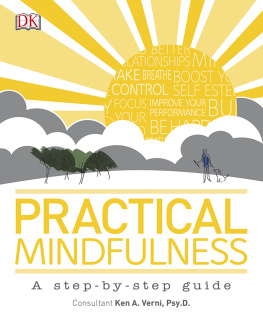
Mindfulness at Work For Dummies
Published by: John Wiley & Sons, Ltd., The Atrium, Southern Gate, Chichester, www.wiley.com
This edition first published 2014
2014 John Wiley & Sons, Ltd, Chichester, West Sussex.
Registered office
John Wiley & Sons Ltd, The Atrium, Southern Gate, Chichester, West Sussex, PO19 8SQ, United Kingdom
For details of our global editorial offices, for customer services and for information about how to apply for permission to reuse the copyright material in this book please see our website at www.wiley.com .
The right of the author to be identified as the author of this work has been asserted in accordance with the Copyright, Designs and Patents Act 1988.
All rights reserved. No part of this publication may be reproduced, stored in a retrieval system, or transmitted, in any form or by any means, electronic, mechanical, photocopying, recording or otherwise, except as permitted by the UK Copyright, Designs and Patents Act 1988, without the prior permission of the publisher.
Wiley publishes in a variety of print and electronic formats and by print-on-demand. Some material included with standard print versions of this book may not be included in e-books or in print-on-demand. If this book refers to media such as a CD or DVD that is not included in the version you purchased, you may download this material at http://booksupport.wiley.com . For more information about Wiley products, visit www.wiley.com .
Designations used by companies to distinguish their products are often claimed as trademarks. All brand names and product names used in this book are trade names, service marks, trademarks or registered trademarks of their respective owners. The publisher is not associated with any product or vendor mentioned in this book.
LIMIT OF LIABILITY/DISCLAIMER OF WARRANTY : WHILE THE PUBLISHER AND AUTHOR HAVE USED THEIR BEST EFFORTS IN PREPARING THIS BOOK, THEY MAKE NO REPRESENTATIONS OR WARRANTIES WITH THE RESPECT TO THE ACCURACY OR COMPLETENESS OF THE CONTENTS OF THIS BOOK AND SPECIFICALLY DISCLAIM ANY IMPLIED WARRANTIES OF MERCHANTABILITY OR FITNESS FOR A PARTICULAR PURPOSE. IT IS SOLD ON THE UNDERSTANDING THAT THE PUBLISHER IS NOT ENGAGED IN RENDERING PROFESSIONAL SERVICES AND NEITHER THE PUBLISHER NOR THE AUTHOR SHALL BE LIABLE FOR DAMAGES ARISING HEREFROM. IF PROFESSIONAL ADVICE OR OTHER EXPERT ASSISTANCE IS REQUIRED, THE SERVICES OF A COMPETENT PROFESSIONAL SHOULD BE SOUGHT.
For general information on our other products and services, please contact our Customer Care Department within the U.S. at 877-762-2974, outside the U.S. at (001) 317-572-3993, or fax 317-572-4002. For technical support, please visit www.wiley.com/techsupport .
For technical support, please visit www.wiley.com/techsupport .
A catalogue record for this book is available from the British Library.
ISBN 978-1-118-72799-7 (paperback) ISBN 978-1-118-72797-3 (ebk) ISBN 978-1-118-72790-4 (ebk)
Printed in Great Britain by Bell & Bain, Ltd., Glasgow.
10 9 8 7 6 5 4 3 2 1
Chapter 1
Exploring Mindfulness in the Workplace
In This Chapter
 Identifying what mindfulness is and is not
Identifying what mindfulness is and is not
 Retraining your brain
Retraining your brain
 Getting started
Getting started
In tough economic times, many organisations are looking for new ways to deliver better products and services to customers while simultaneously reducing costs. Carrying on as normal is not isnt an option. Organisations are looking for sustainable ways to be more innovative. Leaders must really engage staff, and everyone needs to become more resilient in the face of ongoing change. For these reasons, more and more organisations are offering staff training in mindfulness.
Major corporations in the USA, like General Mills, and major employers in the UK, such as the National Health Service, have offered staff mindfulness training in recent years. Google and eBay are among the many companies that now provide rooms for staff to practise mindfulness in work time. Business schools including Harvard Business School in the USA and Ashridge Business School in the UK now include mindfulness principles in their leadership programmes.
So what is mindfulness, and why are so many leading organisations investing in it?
Becoming More Mindful at Work
In this section you will discover what mindfulness is. More importantly, youll also discover what mindfulness is not! Youll find out how mindfulness evolved and why its become so important in the modern day workplace.
Clarifying what mindfulness is
Have you ever driven somewhere and arrived at your destination remembering nothing about your journey? Or grabbed a snack and noticed a few moments later that all you have left is an empty packet? Most people have! These examples are common ones of mindlessness, or going on automatic pilot.
Like many humans, youre probably not present for much of your own life. You may fail to notice the good things in your life or hear what your body is telling you. You probably also make your life harder than it needs to be by poisoning yourself with toxic self-criticism.
Mindfulness can help you to become more aware of your thoughts, feelings and sensations in a way that suspends judgement and self-criticism. Developing the ability to pay attention to and see clearly whatever is happening moment by moment does not eliminate lifes pressures, but it can help you respond to them in a more productive, calmer manner.
Learning and practising mindfulness can help you to recognise and step away from habitual, often unconscious emotional and physiological reactions to everyday events. Practising mindfulness allows you to be fully present in your life and work and improves your quality of life.
Mindfulness can help you to:
- Recognise, slow down or stop automatic and habitual reactions
- Respond more effectively to complex or difficult situations
- See situations with greater focus and clarity
- Become more creative
- Achieve balance and resilience at both work and home
Mindfulness at work is all about developing awareness of thoughts, emotions and physiology and how they interact with one another. Mindfulness is also about being aware of your surroundings, helping you better understand the needs of those around you.Mindfulness training is like going to the gym. In the same way as training a muscle, you can train your brain to direct your attention to where you want it to be. In simple terms, mindfulness is all about managing your mind.
Taking a look at the background
Mindfulness has its origins in ancient Eastern meditation practices. Jon Kabat-Zinn developed Mindfulness-Based Stress Reduction (MBSR) in the USA in the late 1970s, which became the foundation for modern-day mindfulness. Figure shows how it developed.

Figure 1-1: Mindfulness timeline.
In the 1990s Mark Williams, John Teasdale and Zindel Segal further developed MBSR to help people suffering from depression. Mindfulness Based Cognitive Therapy (MBCT) combined cognitive behavioural therapy (CBT) with mindfulness. In 2004, MBCT was clinically approved in the UK by the National Institute for Clinical Excellence (NICE) as a treatment of choice for recurrent depression.















 Identifying what mindfulness is and is not
Identifying what mindfulness is and is not